Oleotourism as a Sustainable Product: An Analysis of Its Demand in the South of Spain (Andalusia)
Abstract
1. Introduction
2. Literature Review
3. Materials and Methods
3.1. Area of the Study
3.2. Methodology
- Oleotourist socioeconomic profile: gender, age, educational level, family status, monthly income, etc.
- Itinerary characteristics: price, how one learned of it, where purchased, etc.
- Assessments and opinions on the itinerary: accommodation, restaurants, roads, signage, customer care, etc.
- Degree of satisfaction with the product: visits to oil mills, oil tasting, visits to millenary olive trees, etc.
- Knowledge of olive oil: habitual olive oil consumption, distinguishing between virgin and extra virgin olive oil, etc.
Zt = (1 − B)d (1 − Bs)D Ytλ
4. Results
4.1. Univariate Results
4.2. Results of the SWOT Analysis
- -
- A good road and rail network connected with the rest of Spain.
- -
- The oil and wine itineraries tend to pass through areas conducive to other activities: hiking, hunting and fishing, etc.
- -
- Access to an important number of sites of artistic and monumental heritage.
- -
- Access to festivities and cultural activities (carnivals, Easter, pilgrimages, flamenco festivals, etc.) throughout the year.
- -
- There is a great regional tourism tradition with much experience in the sector.
- -
- Little dependence on favorable climatic conditions to carry out many of the rural activities.
- -
- Inadequate hotel infrastructure at certain times of the year (rural houses and rural hotels).
- -
- Inadequate training of the sector’s workers and entrepreneurs.
- -
- Absence of awareness about this potential source of income that is beyond that of agriculture.
- -
- Little co-ordination between the actions promoted by the tourism sector and that of the other sectors (lack of a strategic vision).
- -
- Progressive increase of consumers demanding higher quality and willing to pay higher prices for local products that are organic and/or bear the Protected Designation of Origin label.
- -
- An increase of free time among potential tourists which promotes the development of an important free time and/or leisure industry.
- -
- A change in the habits and values of individuals resulting in a new sensitivity as to what sustainable rural tourism represents (experiences in a rural/natural and traditional environment).
- -
- An obvious saturation of traditional destinations (such as sun and beach).
- -
- The increase in awareness of rural communities where development does not depend on exogenous elements, but on mobilization of local resources.
- -
- Public policies to promote rural development initiatives such as the LEADER (Liaison Entre Actions de Développement de l'Économie Rurale) I and II, PRODER (Programa Operativo de Desarrollo y Diversificación Económica de las Zonas Rurales) and FEDER (Fonds Européen de Développement Économique et Régional) programs or the Olive Tree Law in Andalusia.
- -
- The lack of entrepreneurs.
- -
- Lack of experience in the marketing of this type of tourism.
- -
- Limited access to finance for small and medium-sized businesses in the sector.
- -
- Existence of seasonality in the sub-sector depending on production (although compensated by complementary activities).
- -
- The economic crisis that reduces the number of tourist visits and spending.
- -
- Certain individuals still link sustainable rural tourism, and gastronomic tourism in particular, with high income (luxury items).
- -
- Persistence of environmental pollution problems that project a negative image to the population and the tourists that visit certain areas.
4.3. Results: Estimating the Demand for Rural Tourism in Andalusia for 2017
tΦ1 = −7.52 *
tθ1= −59.35 *
* Significant parameters α = 0.05
5. Discussion
6. Conclusions
Acknowledgments
Author Contributions
Conflicts of Interest
References
- Calderón, F.J. Sostenibilidad y planificación: Ejes del desarrollo turístico sostenible. Desarrollo Local Sostenible 2010, 3, 1–11. [Google Scholar]
- Ramos, E.; Garrido, D. Towards a “2nd Generation” of quality labels: A proposal for the evaluation of territorial quality marks. Cuadernos de Desarrollo Rural 2014, 11, 101–123. [Google Scholar] [CrossRef]
- Valdés, L. El turismo rural: Una alternativa diversificadora. Líneas estratégicas de su expansion. Papeles de Economía Española 2004, 102, 298–315. [Google Scholar]
- Cánoves, G.; Herrera, L.; Villarino, M. Turismo rural en España: Paisajes y usuarios, nuevos usos y nuevas visions. Cuadernos de Turismo 2005, 15, 63–76. [Google Scholar]
- Bramwell, B.; Lane, B. Sustainable tourism: An evolving global approach. J. Sustain. Tour. 1993, 1, 1–5. [Google Scholar] [CrossRef]
- Lane, B. Sustainable rural tourism strategies: A tool for development and conservation. Revista Interamericana de Ambiente y Turismo 2005, 1, 12–18. [Google Scholar] [CrossRef]
- Garrod, B.; Wornell, R.; Youell, R. Re-conceptualising rural resources as countryside capital: The case of rural tourism. J. Rural Stud. 2006, 22, 117–128. [Google Scholar] [CrossRef]
- Sharpley, R. Flagship attractions and sustainable rural tourism development: The case of the Alnwick Garden, England. J. Sustain. Tour. 2007, 15, 125–143. [Google Scholar] [CrossRef]
- Martínez, V.; Blanco, R. Hacia una gestión sostenible de las actividades turísticas en los espacios rurales y naturales. Revista Internacional de Organizaciones 2013, 10, 131–155. [Google Scholar] [CrossRef]
- Campón-Cerro, A.M.; Di-Clemente, E.; Hernández-Mogollón, J.M.; De Salvo, P.; Calzati, V. Olive oil tourism in Southern Europe: Proposals for tourism development of olive grove rural areas. Turismo & Desenvolvimento 2014, 21, 63–73. [Google Scholar]
- Villanueva-Álvaro, J.J.; Mondéjar-Jiménez, J.; Sáez-Martínez, F.J. Rural Tourism: Development, Management and Sustainability in Rural Establishments. Sustainability 2017, 9, 818. [Google Scholar] [CrossRef]
- Fleischer, A.; Felsenstein, D. Support for small-scale rural tourism: Does it make a difference? Ann. Tour. Res. 2000, 27, 1007–1024. [Google Scholar] [CrossRef]
- Yagüe Perales, R.M. Rural tourism in Spain. Ann. Tour. Res. 2002, 29, 1101–1110. [Google Scholar] [CrossRef]
- Dissart, J.C.; Marcouiller, D. Rural tourism production and the experience scape. Tour. Anal. 2012, 17, 691–704. [Google Scholar] [CrossRef]
- Park, D.B.; Yoon, Y. Segmentation by motivation in rural tourism: A Korean case study. Tour. Manag. 2009, 30, 99–108. [Google Scholar] [CrossRef]
- Ryan, C.; Hughes, K.; Chirgwin, S. The gaze, spectacle and ecotourism. Ann. Tour. Res. 2000, 27, 148–163. [Google Scholar] [CrossRef]
- Frochot, I. A benefit segmentation of tourists in rural areas: A Scottish perspective. Tour. Manag. 2005, 26, 335–346. [Google Scholar] [CrossRef]
- Bel, F.; Lacroix, A.; Lyser, S.; Rambonilaza, T.; Turpin, N. Domestic demand for tourism in rural areas: Insights from summer stays in three French regions. Tour. Manag. 2015, 46, 562–570. [Google Scholar] [CrossRef]
- Pesonen, J.A. Segmentation of rural tourists: Combining push and pull motivations. Tour. Hosp. Manag. 2012, 18, 69–82. [Google Scholar]
- Rid, W.; Ezeuduji, I.O.; Pröbstl-Haider, U. Segmentation by motivation for rural tourism activities in the Gambia. Tour. Manag. 2014, 40, 102–116. [Google Scholar] [CrossRef]
- Greciet, P. Turismo Rural; Ministerio de Agricultura, Pesca y Alimentación: Madrid, Spain, 1994. [Google Scholar]
- Martínez, V. Multiculturalismo en las Sociedades del Ocio; Ediasa, Ediciones Académicas: Madrid, Spain, 2009. [Google Scholar]
- Cohen, S.A.; Prayag, G.; Moital, M. Consumer behaviour in tourism: Concepts, influences and opportunities. Curr. Issues Tour. 2014, 17, 872–909. [Google Scholar] [CrossRef]
- Sanchez, A.; Vargas, E. Turismo sustentable. Un acercamiento a su oferta. Multiciencias 2015, 15, 347–354. [Google Scholar]
- Smith, S.; Costello, C. Culinary tourism: Satisfaction with a culinary event utilizing importance-performance grid analysis. J. Vacat. Mark. 2009, 15, 99–110. [Google Scholar] [CrossRef]
- Eric Amuquandoh, F.; Asafo-Adjei, R. Traditional food preferences of tourists in Ghana. Br. Food J. 2013, 115, 987–1002. [Google Scholar] [CrossRef]
- Aybar, R. Proyecto Oleoturismo: Una Red Europea Para la Promoción de la Cultura del Olivo; Diputación Provincial de Jaén: Jaén, Spain, 2004. [Google Scholar]
- Millán, M.G.; Hernández, R.; Navajas, V. The study of gastronomic tourism in Cordoba and the association of the cuisine. An econometric analysis. Tour. Hosp. Manag. 2016, 22, 173–191. [Google Scholar] [CrossRef]
- Millán, M.G.; Amador, L.; Arjona, J.M. El oleoturismo: Una alternativa para preservar los paisajes del olivar y promover el desarrollo rural y regional de Andalucía (España). Revista de Geografía Norte Grande 2015, 60, 195–214. [Google Scholar] [CrossRef]
- Mogollón, J.M.H.; Fernández, J.A.F.; Cerro, A.M.C. Olive oil tourism in Sierra de Gata and Las Hurdes (Cáceres): An analysis of its potential through a product test. Int. J. Sci. Manag. Tour. 2016, 2, 333–354. [Google Scholar]
- Millán, M.G.; Pérez, L.M. Comparación del perfil de enoturistas y oleoturistas en España. Un estudio de caso. Cuadernos de Desarrollo Rural 2014, 11, 167–188. [Google Scholar]
- Cañero Morales, P.M.C.; Guzmán, T.J.L.G.; Cuadra, S.M.; Agüera, F.O. Análisis de la demanda del oleoturismo en Andalucía/Analysis of demand of olive tourism in Andalusia. Revista de Estudios Regionales 2015, 104, 133–149. [Google Scholar]
- Agüera, F.O.; Cuadra, S.M.; López-Guzmán, T.; Morales, P.C. Estudio de la demanda existente en torno al oleoturismo. El caso de Andalucía. Cuadernos de Turismo 2017, 39, 437–453. [Google Scholar] [CrossRef]
- López-Guzmán, T.; Cañero Morales, P.M.; Moral Cuadra, S.; Orgaz-Agüera, F. An exploratory study of olive tourism consumers. Tour. Hosp. Manag. 2016, 22, 57–68. [Google Scholar] [CrossRef]
- Alonso, A.D. Olives, hospitality and tourism: An Eastern Australian perspective. Br. Food J. 2010, 112, 55–68. [Google Scholar] [CrossRef]
- Alonso, A.D.; Northcote, J. The development of olive tourism in Western Australia: A case study of an emerging tourism industry. Int. J. Tour. Res. 2010, 12, 696708. [Google Scholar] [CrossRef]
- Murgado, E.M. Turning food into a gastronomic experience: Olive oil tourism. Options Mediterranéennes 2013, 106, 97–109. [Google Scholar]
- Ruiz, I.; Molina, V.; Martín, V.M. El oleoturismo como atractivo turístico en el medio rural español. Papers de Turisme 2011, 49–50, 89–103. [Google Scholar]
- Molina, V.; Quesada, J.M.; Ruiz, I. Potencial del oleoturismo como diversificación económica del sector cooperativo agrario: El caso español. Revista de Ciencias Sociales (Ve) 2011, 22, 533–541. [Google Scholar]
- Millán, G.; Arjona, J.M.; Amador, L. A new market segment for olive oil: Olive oil tourism in the south of Spain. Agric. Sci. 2014, 5, 179–185. [Google Scholar] [CrossRef]
- De Salvo, P.; Hernández-Mogollón, J.M.; Di Clemente, E.; Calzati, V. Territory, tourism and local products. The extra virgin oil’s enhancement and promotion: A benchmarking Italy-Spain. Tour. Hosp. Manag. 2013, 19, 23–34. [Google Scholar]
- Sabbatini, V.; Manthoulis, G.; Baourakis, G.; Drakos, P.; Angelakis, G.; Zopounidis, C. Tourists’ behavioural analysis on olive oil consumption: Empirical results. Int. J. Tour. Policy 2016, 6, 136–146. [Google Scholar] [CrossRef]
- Ministry of Agriculture, Food and Environment. Encuesta Sobre Superficies y Rendimientos de Cultivos 2016; Ministerio de Agricultura, Pesca, Alimentación y Medio Ambiente: Madrid, Spain, 2017.
- Box, G.E.; Jenkins, G.M.; Reinsel, G.C.; Ljung, G.M. Time Series Analysis: Forecasting and Control; John Wiley & Sons: Hoboken, NJ, USA, 2015. [Google Scholar]
- Gujarati, D.N. Econometría; Mc. Graw Hill: New York, NY, USA, 2003. [Google Scholar]
- Chu, F.L. Forecasting tourism demand with ARMA-based methods. Tour. Manag. 2009, 30, 740–751. [Google Scholar] [CrossRef]
- Song, H.; Li, G. Tourism demand modelling and forecasting. Tour. Manag. 2008, 29, 203–220. [Google Scholar] [CrossRef]
- Kulendran, N.; Shan, J. Forecasting China’s monthly inbound travel demand. J. Travel Tour. Mark. 2002, 13, 5–19. [Google Scholar] [CrossRef]
- Torres, E.; Ramirez, R.; Rodriguez Díaz, B. La crisis económica en el sector turístico. Un análisis de sus efectos en la Costa del Sol. Revista de Análisis Turístico 2014, 18, 11–18. [Google Scholar]
- Goh, C.; Law, R. Modeling and forecasting tourism demand for arrivals with stochastic nonstationary seasonality and intervention. Tour. Manag. 2002, 23, 499–510. [Google Scholar] [CrossRef]
- Lin, C.J.; Chen, H.F.; Lee, T.S. Forecasting tourism demand using time series, artificial neural networks and multivariate adaptive regression splines: Evidence from Taiwan. Int. J. Bus. Adm. 2011, 2, 14–24. [Google Scholar]
- Apergis, N.; Mervar, A.; Payne, J.E. Forecasting disaggregated tourist arrivals in Croatia: Evidence from seasonal univariate time series models. Tour. Econ. 2017, 23, 78–98. [Google Scholar] [CrossRef]
- Liang, Y.H. Forecasting models for Taiwanese tourism demand after allowance for Mainland China tourists visiting Taiwan. Comput. Ind. Eng. 2014, 74, 111–119. [Google Scholar] [CrossRef]
- Chu, F.L. Using a logistic growth regression model to forecast the demand for tourism in Las Vegas. Tour. Manag. Perspect. 2014, 12, 62–67. [Google Scholar] [CrossRef]
- Chen, L.; Li, G.; Wu, D.C.; Shen, S. Forecasting Seasonal Tourism Demand Using a Multi-Series Structural Time Series Method. J. Travel Res. 2017. [Google Scholar] [CrossRef]
- Veloce, W. Forecasting inbound Canadian tourism: An evaluation of error corrections model forecasts. Tour. Econ. 2014, 10, 263–280. [Google Scholar] [CrossRef]
- Brida, J.G.; Garrido, N. Tourism forecasting using SARIMA models in Chilean regions. International. J. Leis. Tour. Mark. 2011, 2, 176–190. [Google Scholar]
- Loganathan, N.; Ibrahim, Y. Forecasting international tourism demand in Malaysia using Box Jenkins sarima application. South Asian J. Tour. Heritage 2010, 3, 50–60. [Google Scholar]
- Instituto de Estadística y Cartografía de Andalucía. Encuesta de Coyuntura Turistica en Andalucia 2017; Junta de Andalucía: Sevilla, Spain, 2017. [Google Scholar]
- Consejería de Turismo y Deporte. Turismo de Interior en Andalucía, Año 2016; Junta de Andalucía: Sevilla, Spain, 2017. [Google Scholar]
- Del Rey, R. Enoturismo y Venta de Vino en España; Observatorio ESPAÑOL del Mercado del VINO: Madrid, Spain, 2016. [Google Scholar]
- Conde, N. Análisis de la llegada de turistas internacionales a México. Investigación Administrativa 2013, 42, 20–33. [Google Scholar]

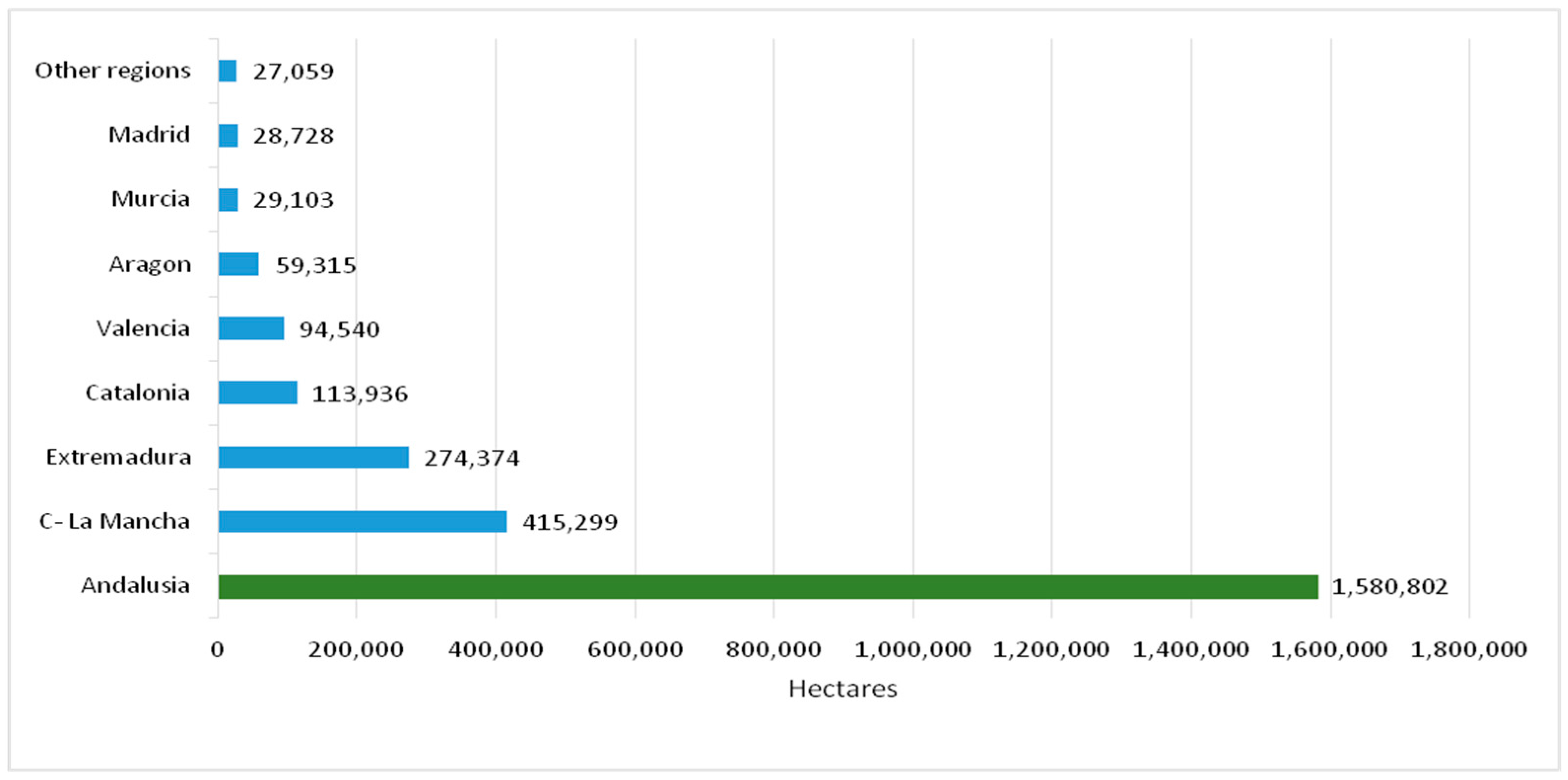
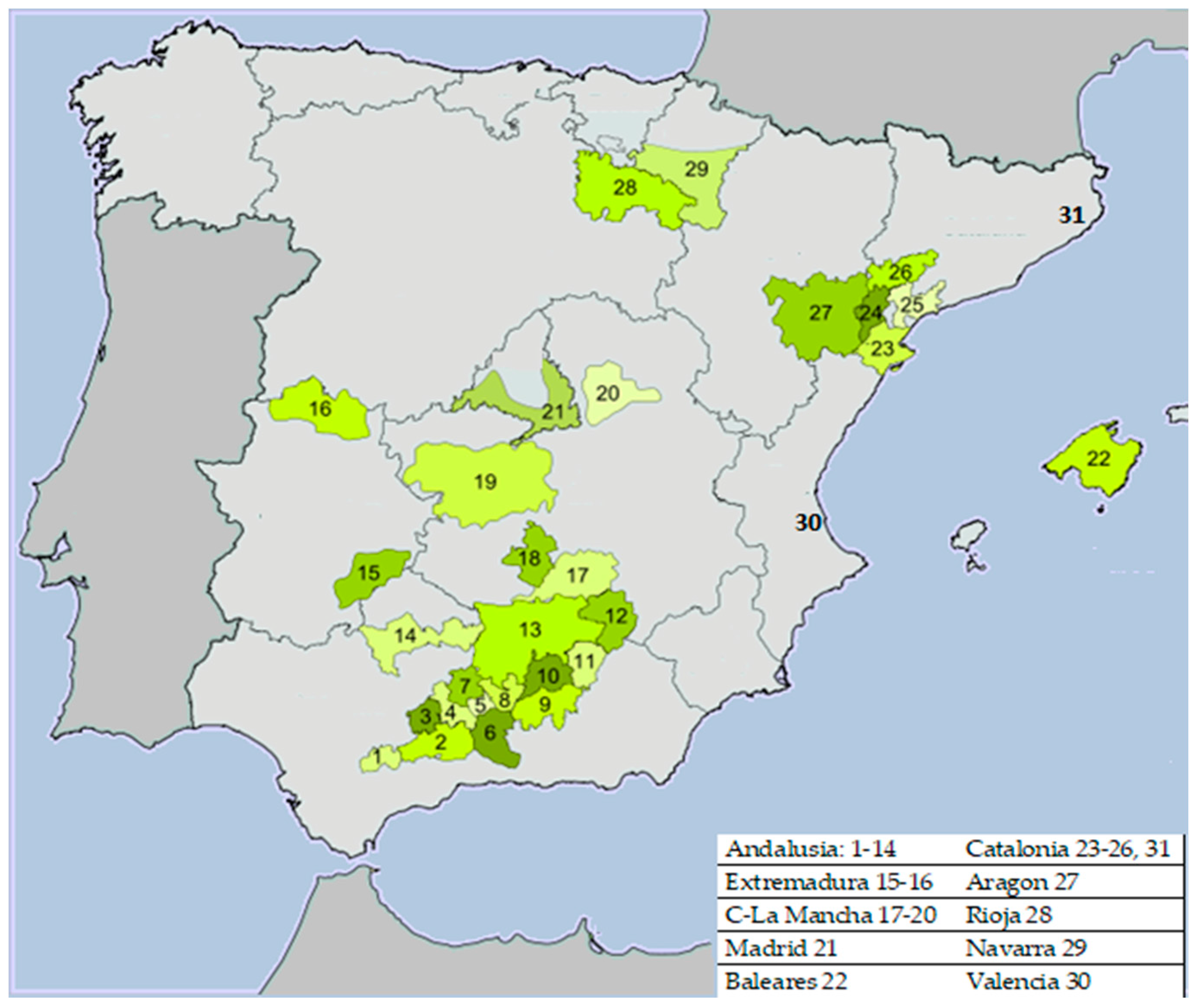

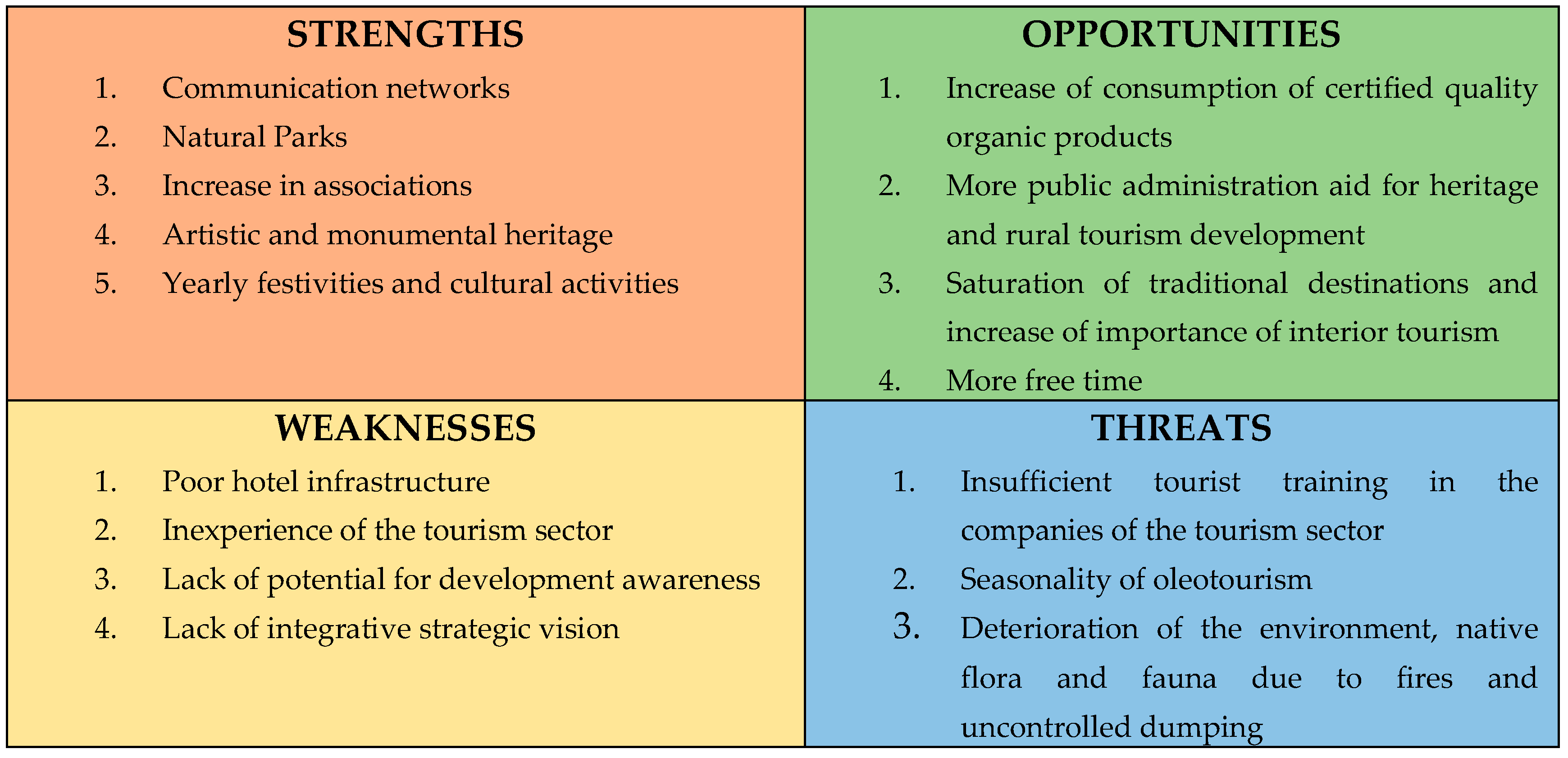
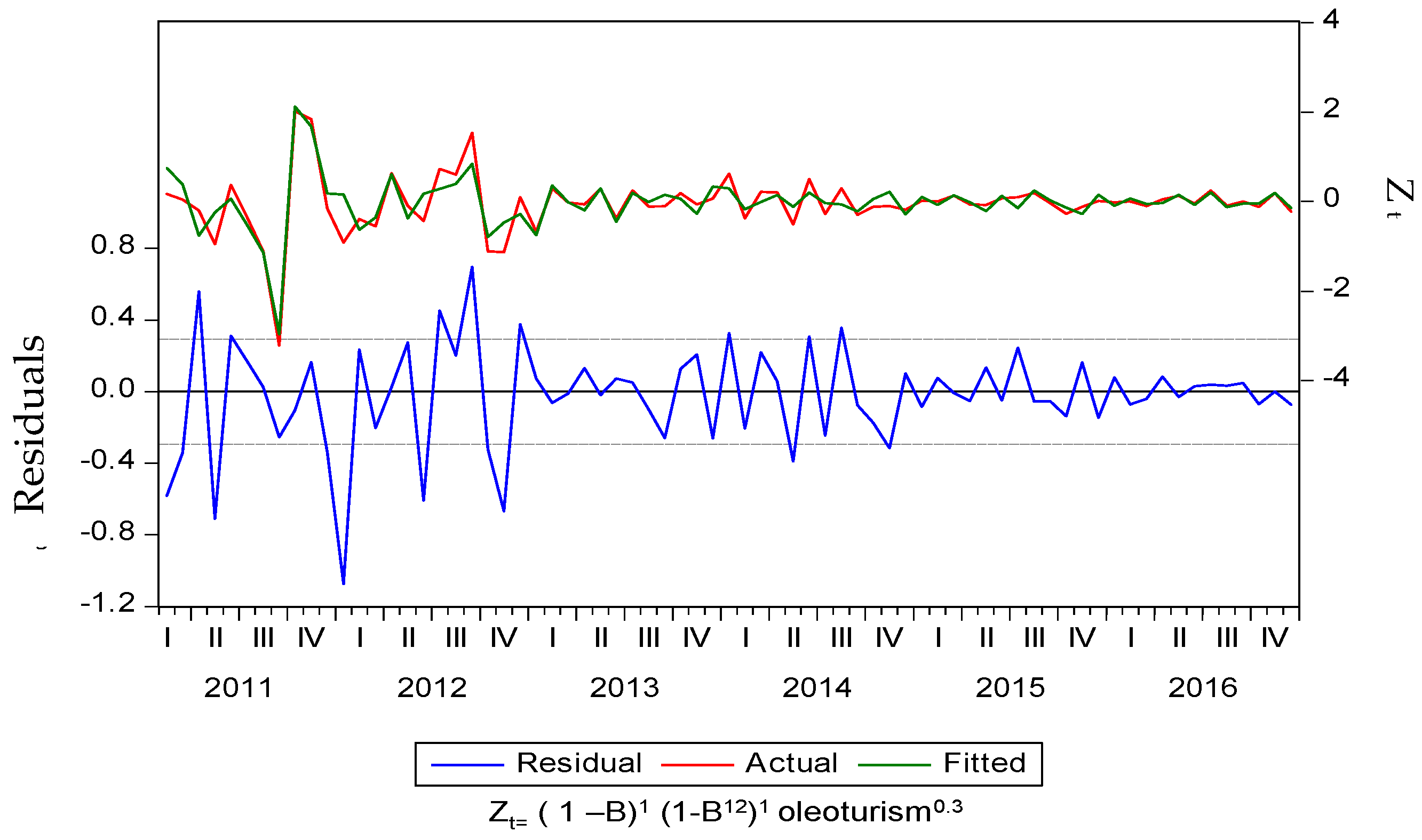
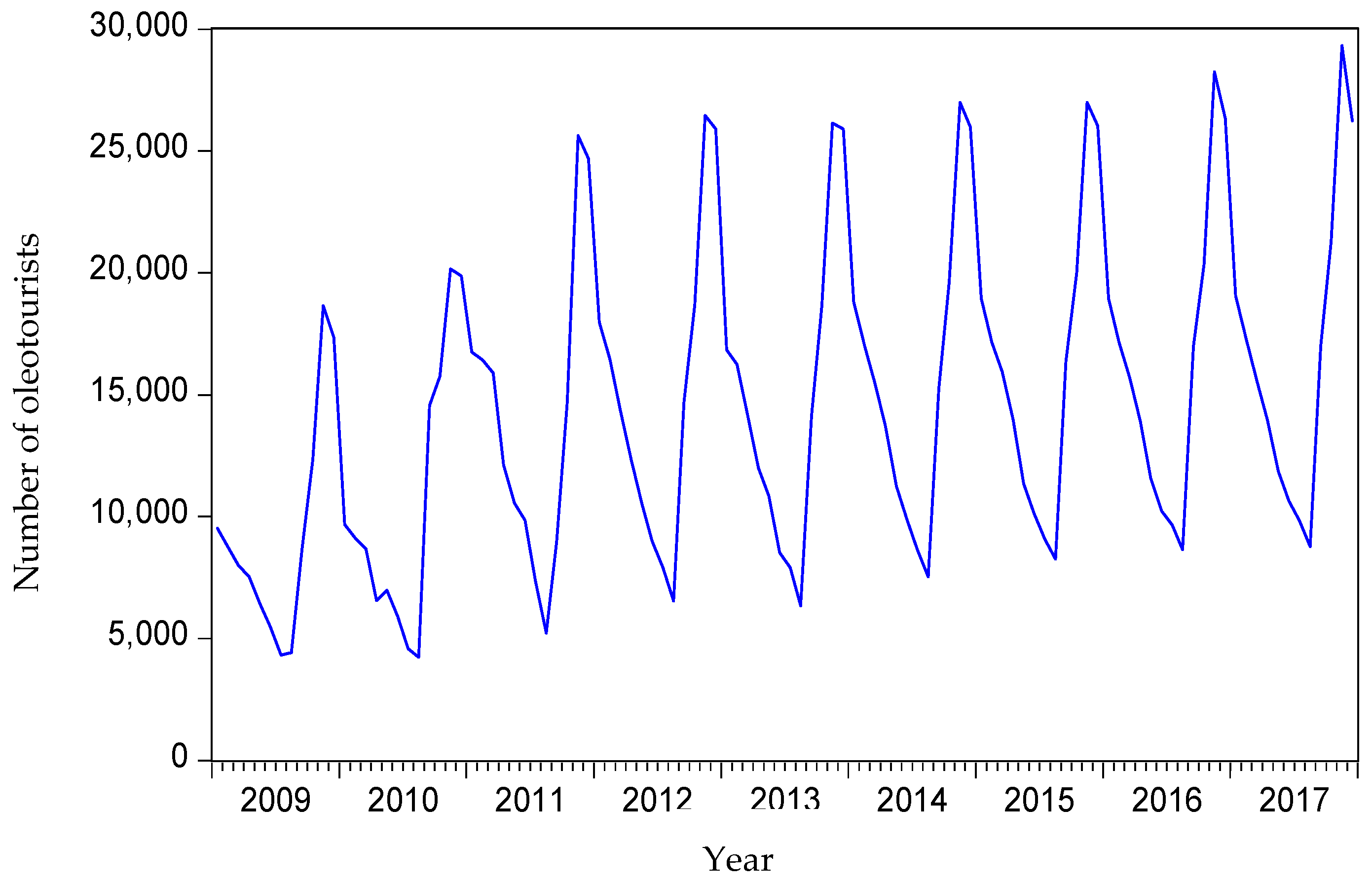
| Passive Resources | |||||
| Natural Resources | Historic-Artistic Heritage | Cultural Expressions | |||
| Landscapes | Monuments | Folklore | |||
| Climate | Castles | Gastronomy (oleotourism) | |||
| Natural parks | Popular architecture | Religious celebrations | |||
| Recreational areas | Sculpture | Artistic festivals | |||
| Roads, trails, routes | Handicrafts: smithy, pottery | Ferias (Fairs) | |||
| Wildlife | Sites | Carnivals | |||
| Flora | Customs and popular traditions | ||||
| Active Resources | |||||
| Recreational Sports | Socio-Cultural | Rural Participation | Others | ||
| Mountaineering | Handicrafts | Agricultural activities | Painting | ||
| River tours | Languages | Livestock | Photography | ||
| Trekking | Study of flora | Smithies, basketwork, etc. | Thermal baths | ||
| Speleology | Wildlife study | Manufacture of local products | Ecological activities | ||
| Horse riding | Study of environment | ||||
| Cycling | |||||
| Autonomous Communities | Almazaras (Oil Mills) | Packaging | Orujera * | Refineries | Packaging/Curing | Laboratories |
|---|---|---|---|---|---|---|
| Andalusia | 818 | 669 | 39 | 15 | 242 | 349 |
| Aragon | 103 | 108 | 1 | 1 | 37 | 16 |
| Balearic Islands | 9 | 19 | 3 | 88 | ||
| Castile-La Mancha | 252 | 240 | 9 | 3 | 10 | 1 |
| Castile and Leon | 19 | 19 | 9 | 55 | ||
| Catalonia | 197 | 221 | 6 | 4 | 28 | 39 |
| Extremadura | 119 | 115 | 7 | 104 | 9 | |
| Galicia | 3 | 4 | ||||
| Madrid | 20 | 25 | 17 | 13 | ||
| Murcia | 40 | 42 | 16 | 3 | ||
| Navarre | 17 | 18 | 1 | 1 | 4 | 3 |
| Basque C. | 4 | 5 | 2 | 1 | ||
| La Rioja | 22 | 25 | 2 | 32 | ||
| Valencia C. | 133 | 133 | 13 | 8 | ||
| TOTAL | 1756 | 1643 | 63 | 24 | 487 | 617 |
| Population | Male and female tourists 18 years of age or more on a visit to the PDO |
| Sample size | 564 valid questionnaires |
| Margin of error | ±4.6% |
| Level of confidence | 96%; p = q = 0.5 * |
| Sampling system | Simple random |
| Fieldwork dates | September 2016–February 2017 |
| Characteristics | Percentages | ||
|---|---|---|---|
| Itinerary | Number of days | Less than 24 h | 62.7% |
| Between 2 and 3 days | 29.1% | ||
| More than 3 days | 8.2% | ||
| Average daily expenses | Less than €35 | 27.2% | |
| Between €36 and €50 | 53.2% | ||
| More than €50 | 19.6% | ||
| Souvenirs purchased | Yes | 64.8% | |
| No | 35.2% | ||
| Alone or accompanied | Alone | 17.9% | |
| Family | 40.1% | ||
| Friends | 42.0% | ||
| Motivation | Oil mill visits | 48.3% | |
| Know the region | 36.4% | ||
| Visit millenary trees | 5.4% | ||
| Other | 9.9% | ||
| Satisfaction with the destination | Satisfied | 83.2% | |
| Indifferent | 10.7% | ||
| Not satisfied | 6.1% | ||
| Knowledge of olive oil | Consumption of olive oil | Daily | 56.3% |
| More than once a week | 24.8% | ||
| Occasionally | 14.6% | ||
| Does not consume | 4.3% | ||
| Knows the different varieties of olive oil | Yes | 84.6% | |
| No | 15.4% | ||
| Type of olive oil consumed | Extra virgin | 64.5% | |
| Virgin | 35.5% | ||
| Motivation to consume olive oil | Good for the health | 48.9% | |
| For the taste it gives dishes | 48.5% | ||
| Other | 2.6% |
| Dependent Variable: D(OLEOTOURISM1,1,12) | ||||
|---|---|---|---|---|
| Variable | Coefficient | Std. Error | t-Statistic | Prob. |
| AR(12) | −0.338695 | 0.044980 | −7.529977 | 0.0000 |
| MA(12) | 0.977792 | 0.016474 | 59.35276 | 0.0000 |
| Autocorrelation | Partial Correlation | Q-Stat | Prob. | |
|---|---|---|---|---|
| 1 | −0.025 | −0.025 | 0.0468 | |
| 2 | −0.250 | −0.251 | 4.7444 | |
| 3 | −0.125 | −0.149 | 5.9386 | 0.015 |
| 4 | −0.042 | −0.127 | 6.0628 | 0.048 |
| 5 | 0.149 | 0.074 | 7.7955 | 0.051 |
| 6 | −0.174 | −0.245 | 10.221 | 0.037 |
| 7 | −0.148 | −0.072 | 11.454 | 0.051 |
| 8 | 0.051 | −0.069 | 11.664 | 0.070 |
| 9 | 0.096 | −0.010 | 12.437 | 0.087 |
| 10 | 0.065 | −0.023 | 12.796 | 0.119 |
| 11 | −0.066 | −0.030 | 13.170 | 0.155 |
| 12 | −0.018 | −0.016 | 13.198 | 0.213 |
| 13 | 0.120 | 0.086 | 14.477 | 0.208 |
| 14 | −0.165 | −0.212 | 16.943 | 0.152 |
| 15 | −0.119 | −0.112 | 18.255 | 0.148 |
| 16 | 0.085 | 0.027 | 18.931 | 0.168 |
| 17 | 0.078 | −0.006 | 19.517 | 0.191 |
| 18 | 0.151 | 0.099 | 21.744 | 0.152 |
| 19 | −0.170 | −0.103 | 24.612 | 0.104 |
| 20 | 0.075 | 0.160 | 25.177 | 0.120 |
| 21 | 0.144 | 0.081 | 27.320 | 0.097 |
| 22 | −0.023 | 0.052 | 27.374 | 0.125 |
| 23 | 0.074 | 0.211 | 27.964 | 0.141 |
| 24 | −0.046 | −0.034 | 36.312 | 0.098 |
| 25 | −0.027 | 0.025 | 36.394 | 0.058 |
| 26 | −0.148 | 0.072 | 37.672 | 0.051 |
| 27 | 0.009 | 0.069 | 37.682 | 0.050 |
| 28 | −0.021 | −0.036 | 37.736 | 0.064 |
| 29 | −0.046 | 0.009 | 37.992 | 0.078 |
| 30 | 0.046 | −0.001 | 38.255 | 0.094 |
| 31 | −0.026 | −0.119 | 38.343 | 0.115 |
| 32 | 0.003 | 0.059 | 38.345 | 0.141 |
| F-statistic | 1.931435 | Prob. F(1,68) | 0.1691 |
| Obs * R-squared | 1.933329 | Prob. Chi-Square(1) | 0.1644 |
| t-Statistic | Prob. * | ||
|---|---|---|---|
| Augmented Dickey–Fuller test statistic | −2.561844 | 0.1050 | |
| Test critical values | 1% level | −3.510259 | |
| 5% level | −2.896346 | ||
| 10% level | −2.585396 | ||
| Year 2016 | Year 2017 | |
|---|---|---|
| January | 18,956 | 19,051 |
| February | 17,169 | 17,245 |
| March | 15,687 | 15,538 |
| April | 13,896 | 13,956 |
| May | 11,563 | 11,864 |
| June | 10,231 | 10,635 |
| July | 9653 | 9846 |
| August | 8642 | 8764 |
| September | 16,987 | 17,023 |
| October | 20,354 | 21,269 |
| November | 28,254 | 29,325 |
| December | 26,345 | 26,245 |
| TOTAL | 197,737 | 200,761 |
© 2018 by the authors. Licensee MDPI, Basel, Switzerland. This article is an open access article distributed under the terms and conditions of the Creative Commons Attribution (CC BY) license (http://creativecommons.org/licenses/by/4.0/).
Share and Cite
Millán, M.G.; Pablo-Romero, M.D.P.; Sánchez-Rivas, J. Oleotourism as a Sustainable Product: An Analysis of Its Demand in the South of Spain (Andalusia). Sustainability 2018, 10, 101. https://doi.org/10.3390/su10010101
Millán MG, Pablo-Romero MDP, Sánchez-Rivas J. Oleotourism as a Sustainable Product: An Analysis of Its Demand in the South of Spain (Andalusia). Sustainability. 2018; 10(1):101. https://doi.org/10.3390/su10010101
Chicago/Turabian StyleMillán, María Genoveva, María Del Pópulo. Pablo-Romero, and Javier Sánchez-Rivas. 2018. "Oleotourism as a Sustainable Product: An Analysis of Its Demand in the South of Spain (Andalusia)" Sustainability 10, no. 1: 101. https://doi.org/10.3390/su10010101
APA StyleMillán, M. G., Pablo-Romero, M. D. P., & Sánchez-Rivas, J. (2018). Oleotourism as a Sustainable Product: An Analysis of Its Demand in the South of Spain (Andalusia). Sustainability, 10(1), 101. https://doi.org/10.3390/su10010101







